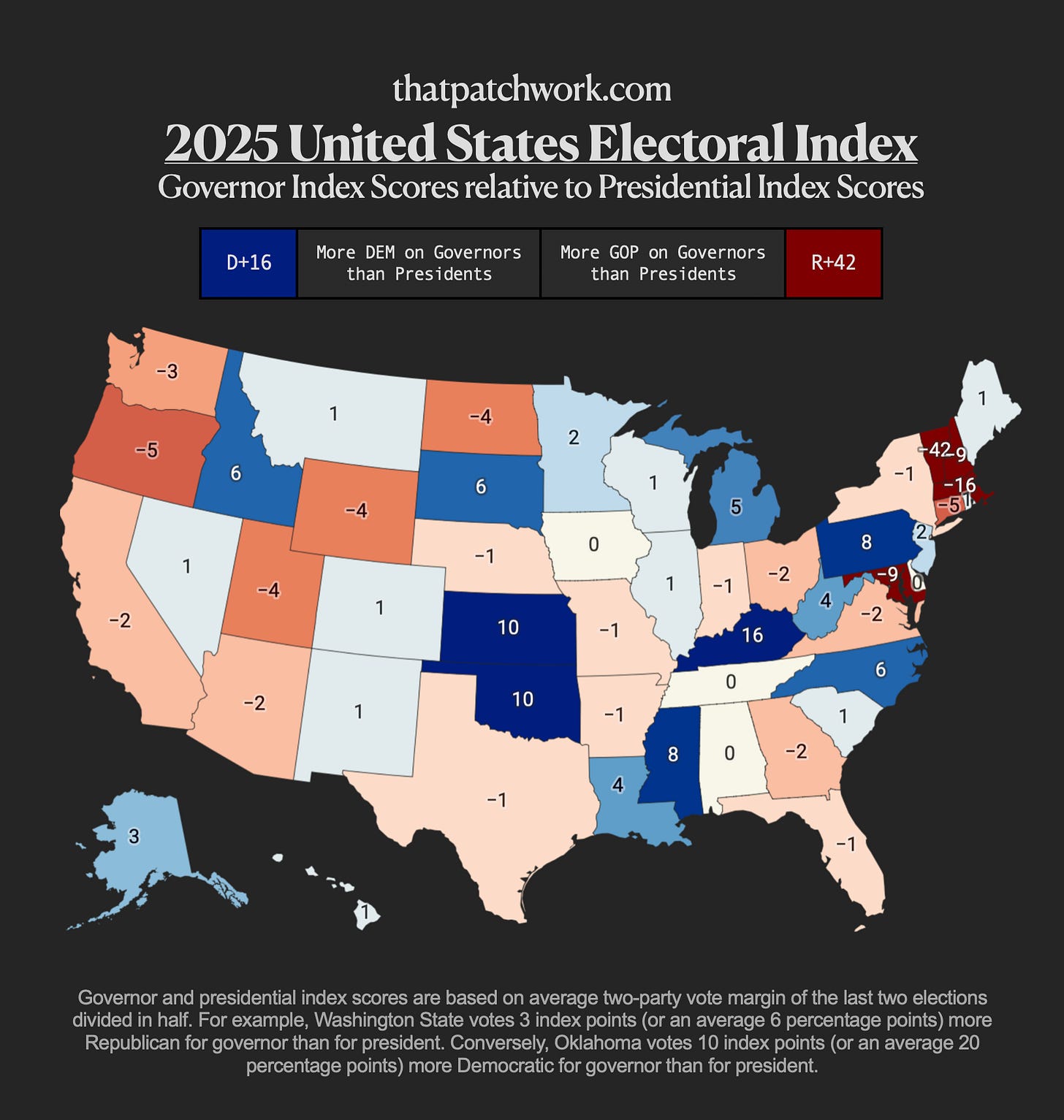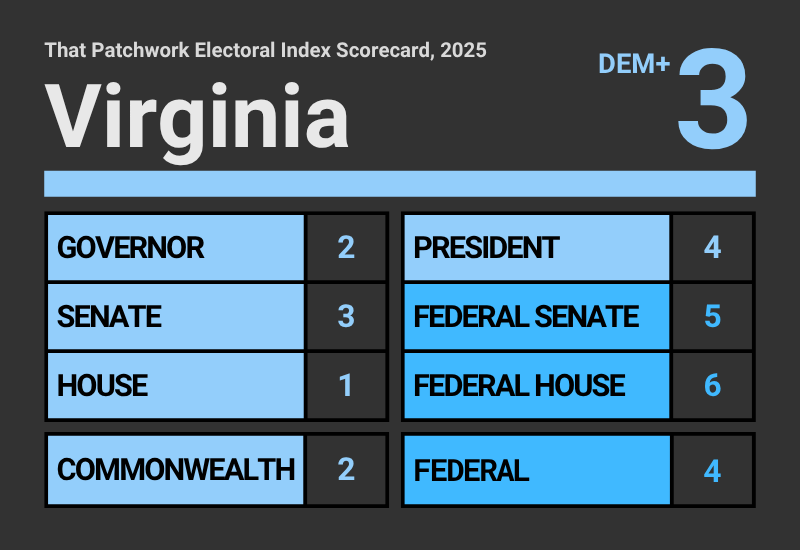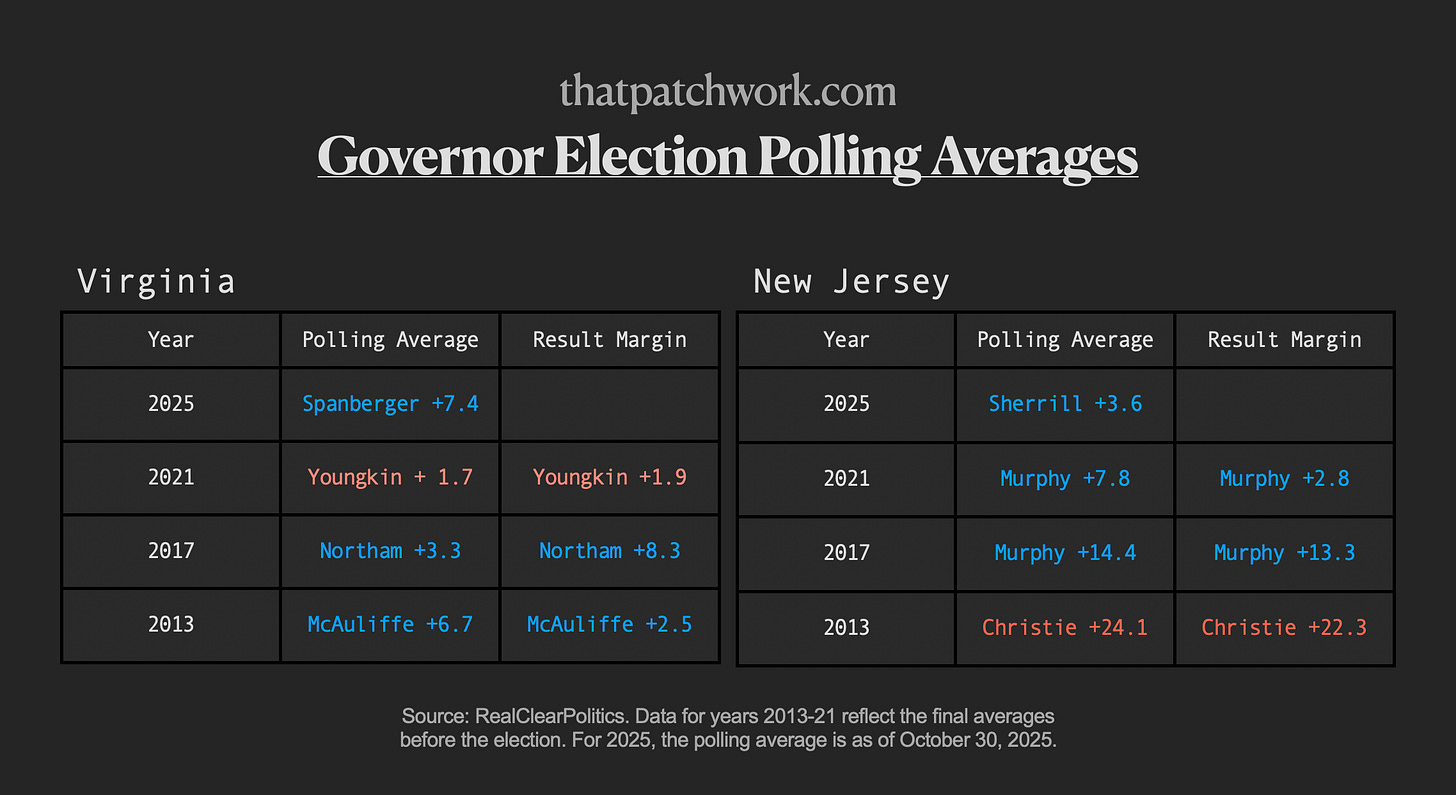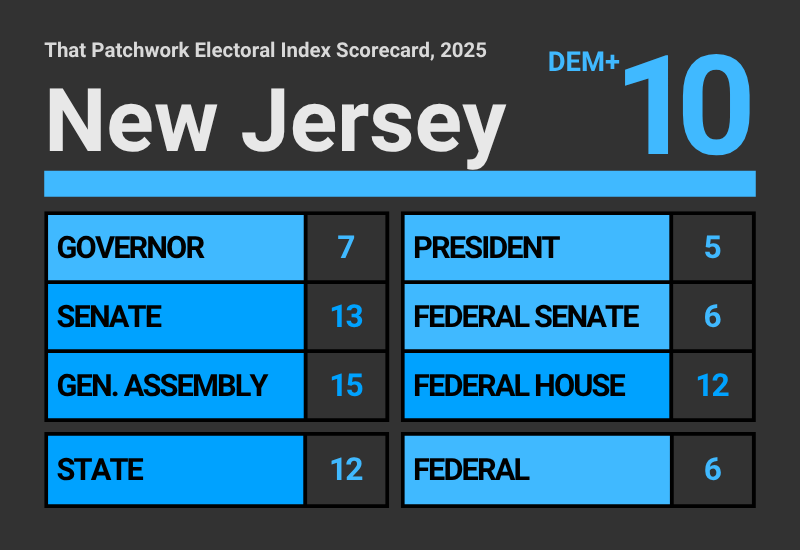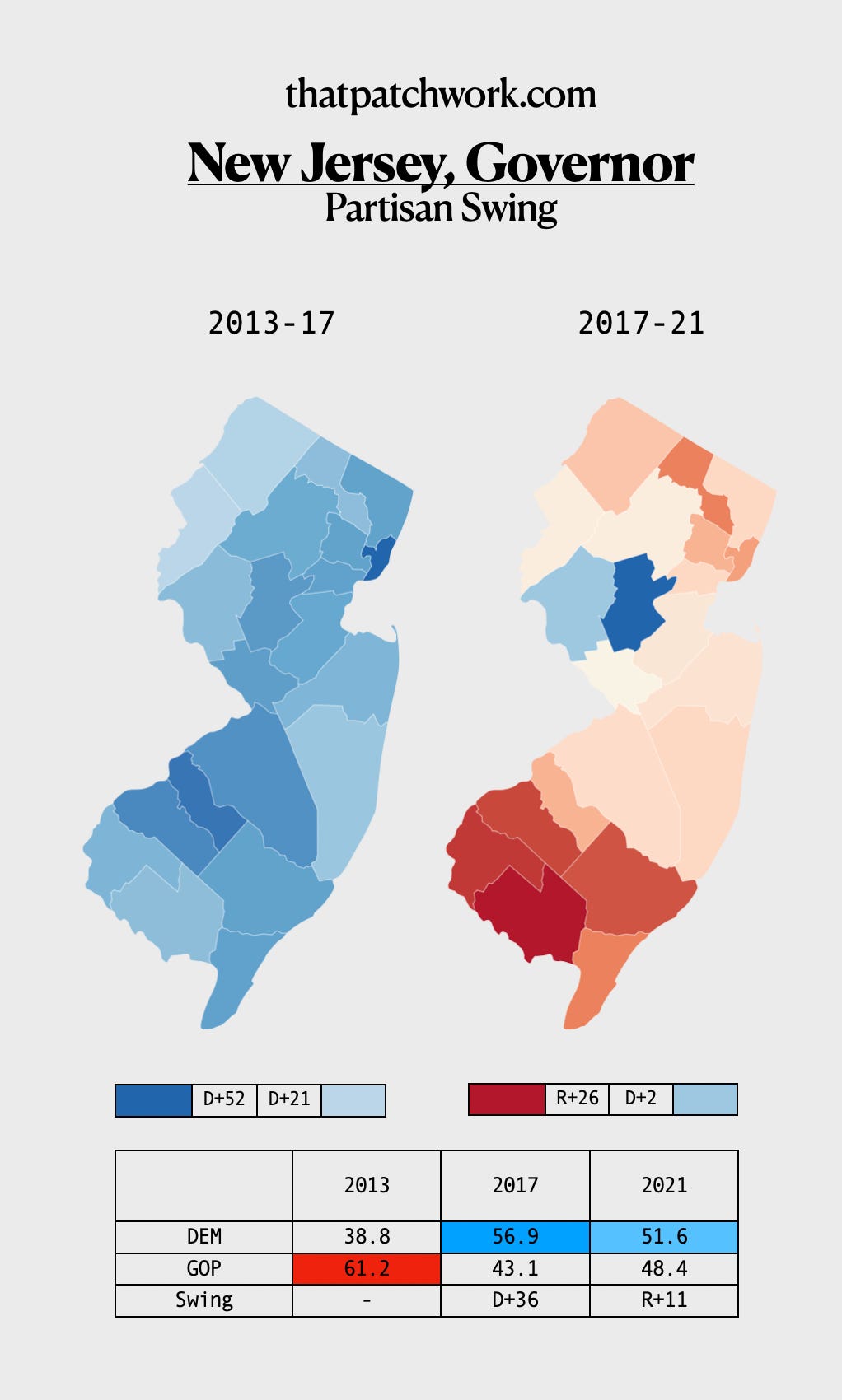Nope, Virginia and New Jersey Still Aren't National Bellwethers
Voters' choices for governor diverge from their presidential picks. Local issues remain dominant in these state races.
Every four years, national commentators rush to make the Virginia and New Jersey elections a referendum on the sitting president—or on the person he defeated the year before—and every four years I end up writing about why these races remain, at their core, local contests.
It’s worth acknowledging how national politics seeps into and distorts state and local dynamics. When every perception of a candidate traces back to their party’s standing in the last presidential race, the presidency becomes an imperial metric for all politics—even as we wring our hands about the authoritarianism that radiates from Washington. National media, especially cable news, thrive on elections; their easiest way to make a New Jersey governor’s race relevant to someone in Louisiana is to frame it through the president, the most polarizing and recognizable political figure in the country.
With this post, I want to recap each of the gubernatorial races, the issues driving them, and what they reveal about state-level partisanship beyond presidential voting patterns—something most electoral analysis still fails to capture.
The United States of Governors
First, it’s worth noting that most American electorates for governor diverge meaningfully from their presidential preferences, even when the winning gubernatorial candidate belongs to the same party they supported for president. In addition to writing about decentralization, I also compile electoral data to show how a state-centric, decentralized view of elections can more accurately capture the political composition of the union.
The map below shows governor index scores relative to presidential index scores. Each index score is derived from the average two-party net Democratic vote margin from the last two elections in that category, divided in half. From the map, you’ll see that Virginians vote roughly two index points (or four percentage points in an election) more Republican for governor than for president. Conversely, New Jerseyans vote about two index points more Democratic for governor than for president.
A majority of states have elected governors by margins exceeding two points relative to their presidential results. The most divergent state is Vermont, where a popular Republican governor, Phil Scott, has won multiple landslide re-elections opposite of the state’s strong Democratic lean federally. On the other end, Kentucky stands out for re-electing a Democratic governor, Andy Beshear, even as it has voted overwhelmingly Republican in recent presidential elections.
Overall, Republicans hold a two-point advantage in the median governor’s seat, underscoring the often-overlooked distance between national and state-level voter behavior.
Virginia
Four years ago, Virginians elected businessman Glenn Youngkin, a conventional Republican, in an upset over former Democratic governor Terry McAuliffe, who was seeking a non-consecutive second term. At the time, DC and New York political media largely credited Youngkin’s victory to Joe Biden’s waning popularity. The Biden administration was then facing rising inflation—partly a byproduct of the American Rescue Plan passed that spring—and the fallout from a chaotic withdrawal from Afghanistan. Coming just months after the Capitol riot, Biden, who had campaigned on unity and moderation, warned that extremism could come “from a smile and a fleece vest”—a nod to Youngkin’s signature look.
In truth, McAuliffe—a Clinton-era establishment Democrat who had only narrowly won in 2013—was never a particularly strong candidate. It’s also worth noting that Barack Obama, who carried Virginia by six points in 2008 and still enjoyed majority approval during the fall of the Virginia election that year, saw his party’s nominee, Creigh Deeds, lose the 2009 race to Republican Bob McDonnell by 17 points. In 2017, Democrat Ralph Northam outperformed Hillary Clinton’s 2016 vote share by four points. Together, these examples underscore how limited presidential politics’ influence tends to be on Virginia’s state elections. It’s also important to note that the 2021 Virginia governor election was arguably the first high-profile election to successfully challenge the myth that Republicans could only win in low turnout election as the 2021 race was a highest turnout governor election for the commonwealth since 1993.
More relevant were state-level issues tied to COVID-19 restrictions and public education. Prolonged school closures and mask mandates frustrated parents, especially in suburban areas, creating an opening for Youngkin. He centered his campaign on “parental control” and opposition to pandemic-era mandates, while McAuliffe defended the existing policies. The mix of lingering pandemic fatigue, education-related cultural flashpoints, and perceived government overreach turned schooling into a symbolic battleground—and helped deliver Youngkin a narrow victory.
This year’s race features former congresswoman Abigail Spanberger, who retired from Virginia’s moderately Democratic 7th congressional district to run for governor, against current lieutenant governor Winsome Earle-Sears—the state’s first Black woman elected statewide, a Jamaican immigrant, and a former U.S. Marine. Next week, Virginia will elect its first woman governor. The campaign has revolved around the cost of living, immigration enforcement, public education, and abortion regulation. Earle-Sears has tried to cast Spanberger as a culturally out-of-step progressive, particularly on issues involving transgender students, but she currently trails Spanberger in the polls. In 2022, Spanberger was a critic of progressive rhetoric, particularly the “socialist” label some had embraced that she says resulted in losses of her party. In 2021, she said Biden was elected “to be normal and stop the chaos,” not “to be FDR”.
Spanberger shares the Democratic ticket with Senator Ghazala Hashmi of Chesterfield, who could become Virginia’s first Muslim elected statewide, while Republicans have nominated John Reid, who would be the first openly gay man elected lieutenant governor. For attorney general, incumbent Republican Jason Miyares is seeking reelection against Delegate Jay Jones of Chesapeake. Those races are tighter than the governor’s contest, particularly the attorney general race, where Miyares is even or slightly ahead of Jones, whose campaign was damaged by leaked texts advocating violence against Republicans. Split-partisan outcomes are common in Virginia—six of the last fourteen governors have served alongside executive officers from the opposite party, most recently Tim Kaine in 2005.
Youngkin remains a relatively popular governor, at least by modern standards of what constitutes popular. A Roanoke College poll this week found 50 percent of respondents approved of his performance, versus 36 percent who disapproved and 10 percent who had mixed views. The same survey showed Spanberger’s favorability at 47-42 and Earle-Sears’s at 38-45.
All 100 seats in the Virginia House of Delegates are also up for election. The chamber has see-sawed between the parties for at least the last decade and Republicans would need to gain three seats to retake the majority. Democrats have a 1-seat margin in the Senate and those elections are held next in 2027.
New Jersey
Four years after a surprisingly close re-election, term-limited governor Phil Murphy is leaving office at the end of his second term, opening the door to New Jersey’s most competitive gubernatorial contest in over a decade. The race between Democratic Congresswoman Mikie Sherrill and Republican former Assemblyman Jack Ciattarelli, who Murphy defeated by three points four years ago, reflects a familiar dynamic in the Garden State: voters frustrated by high costs and heavy taxes but reluctant to return a Republican to office.
The story in New Jersey is a curious one. It’s a state that’s comfortably Democratic by almost every measure—from the presidency to the General Assembly—yet far more elastic in its choice of governors than Virginia. In a state presidential Democrats have carried by 15-20 points since 2008, Donald Trump narrowed that gap to 6 points in New Jersey last year. But it’s less Trump having ignited a new propensity among New Jersey voters to consider a Republican so much as New Jerseyans existing propensity to vote for Republicans had, for the first time in a while, transferred over to the presidency.
In Virginia, the last three governors have all won by single-digit margins. In New Jersey, former Republican governor Chris Christie was re-elected by over 20 points in 2013, Democrat Phil Murphy won his first term by a 15 points in 2017, and then barely held on in 2021. Also bear in mind that Murphy was elected in the shadow of Christie’s “Bridgegate” scandal which did no favors for his Republican lieutenant governor’s bid to succeed him. But this pattern also mirrors other northeastern states such as Vermont, New Hampshire, Maine, and to a lesser extent Connecticut—places that lean Democratic overall but periodically favor a Republican for governor, often for fiscal or managerial reasons in high-tax states.
Sherrill is a former Navy helicopter pilot and federal prosecutor who has represented the state’s moderately Democratic 11th congressional district since 2019, specifically the Montclair area just west of Newark. She’s running on as a pragmatic centrist focused on restoring affordability, expanding early-childhood education, and investing in infrastructure. She has emphasized competence and moderation, projecting herself as a steady successor to Murphy but without his polarizing reputation. As of September, an Emerson poll finds Murphy to have a lower approval rating than Youngkin, with 34 percent approving his job and 44 percent disapproving.
Ciattarelli, meanwhile, is making his third bid for governor. His campaign has zeroed in on property taxes, business costs, and crime, arguing that Democratic governance has made New Jersey one of the most expensive and overregulated states in the country. The cost of living is the defining issue of the race. Housing and property taxes remain the highest in the nation, and both candidates have promised relief—Sherrill through targeted rebates and regional cost-adjusted school funding, Ciattarelli through a broad overhaul of the state’s tax code. Voters are also preoccupied with education funding, particularly the long-debated School Funding Reform Act, which suburban districts say penalizes them while underperforming urban schools continue to receive disproportionate aid.
Other issues animating the race include public safety, infrastructure, and abortion access. Sherrill has called for codifying abortion rights at the state level following national rollbacks, while Ciattarelli, who describes himself as “personally pro-life but politically moderate,” has avoided explicit commitments to change current law. Transportation policy—especially the Gateway Tunnel project under the Hudson River—has also re-emerged as a central campaign topic, symbolizing both New Jersey’s dependence on federal cooperation and its frustration with bureaucratic delays.
In the State Assembly, all 80 seats are up for election. Democrats currently hold 52 seats. For perspective, when Chris Christie won re-election by over 20 points in 2013, Democrats’ retained a majority of 48 seats on 53% of the statewide vote, and while no gerrymandering doesn’t eliminate such disparities, it is almost certainly a factor here. Republicans are unlikely to come close to retaking the State Assembly even with a comfortably Ciattarelli win. In the Senate, Democrats have a four-seat majority and the next elections there will be in 2027.
This year’s races show that state politics remain far more independent than the national storylines suggest. Virginia and New Jersey voters, like most Americans, still respond to costs, schools, and governance that shape daily life—not to Washington’s mood swings. The impulse to treat every election as a referendum on the president flattens a country that still governs itself locally on the things that are most immediately relevant to people.



